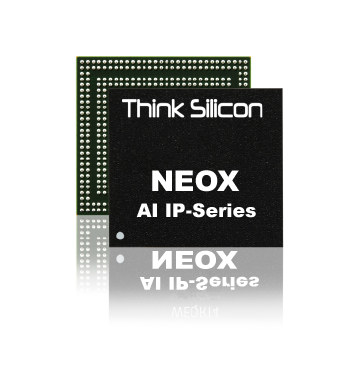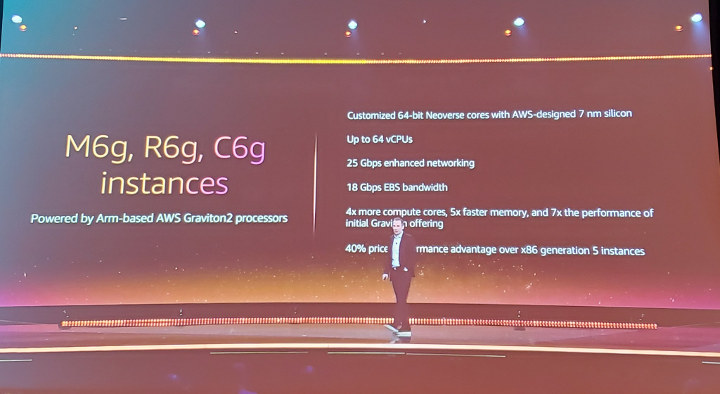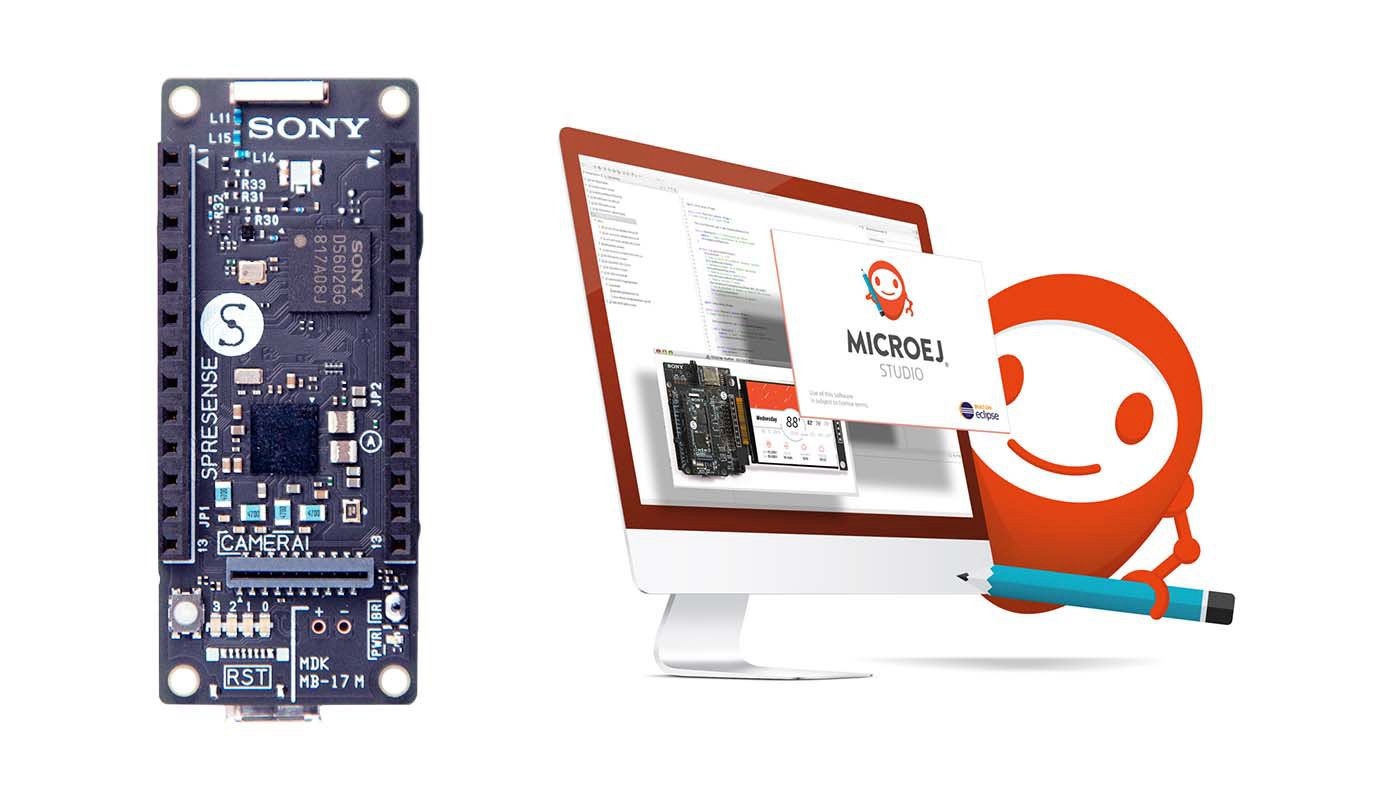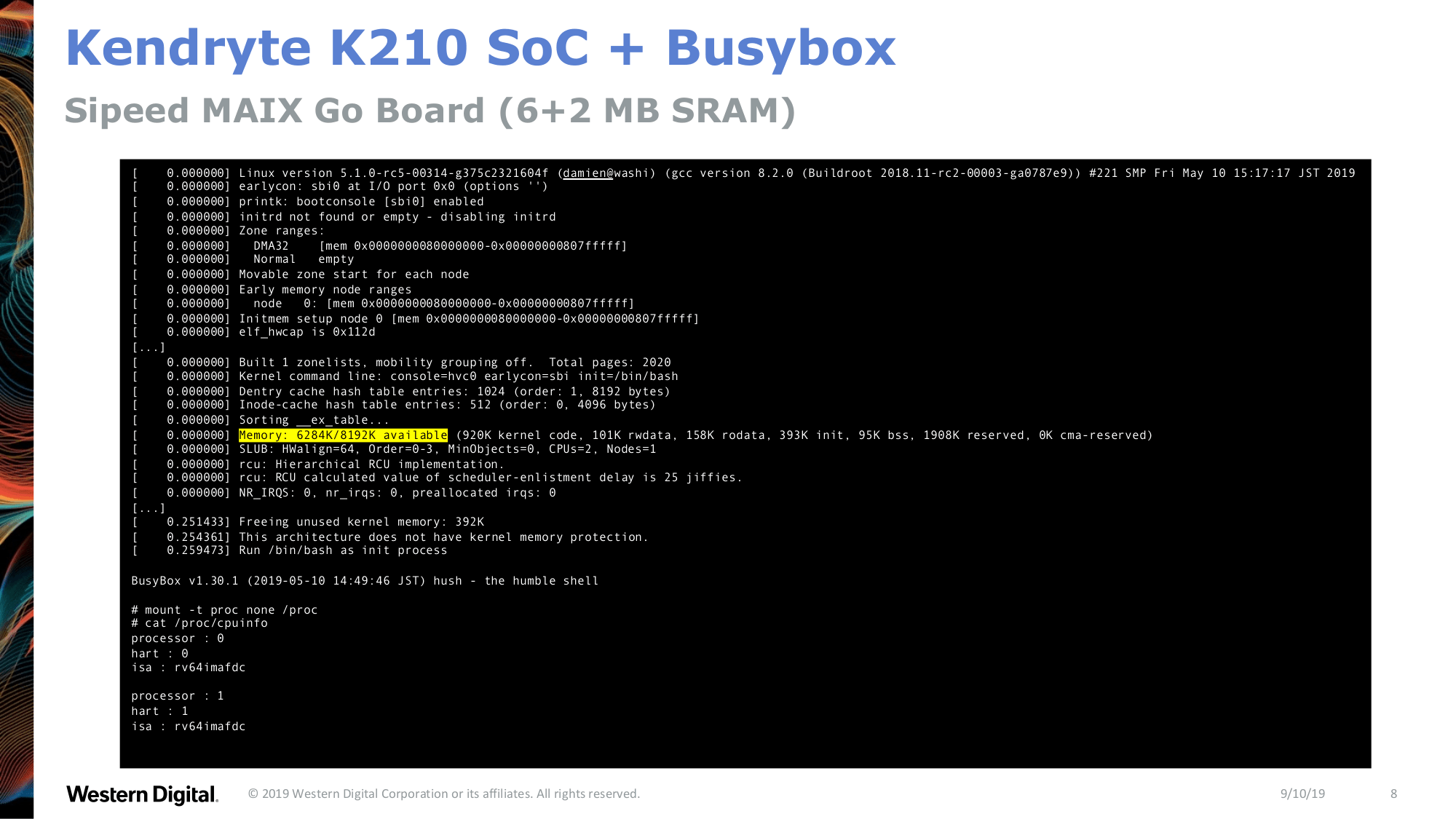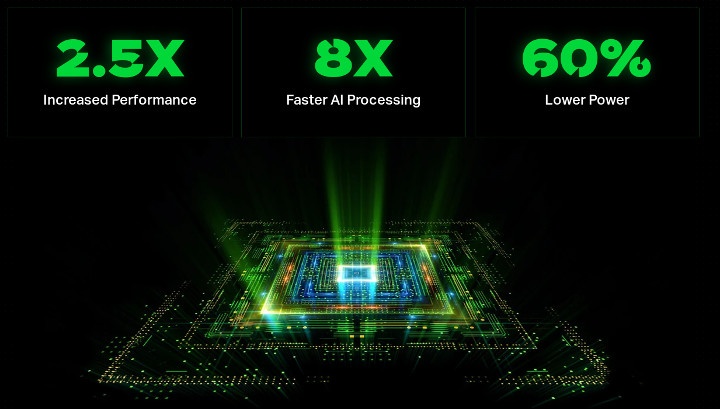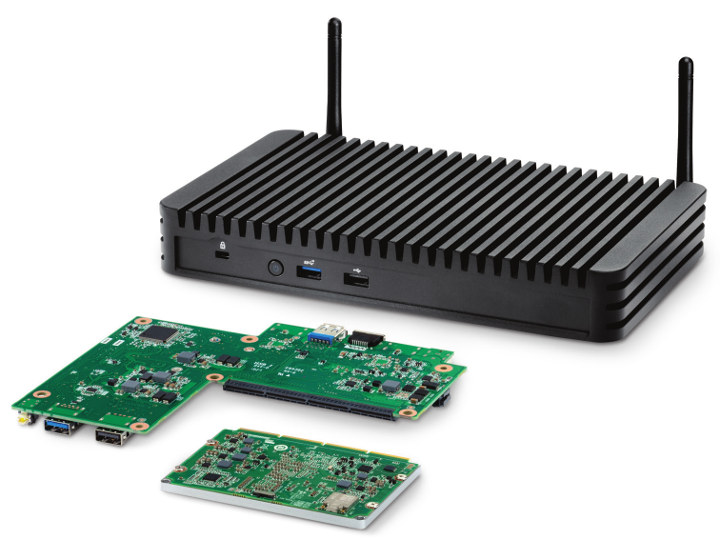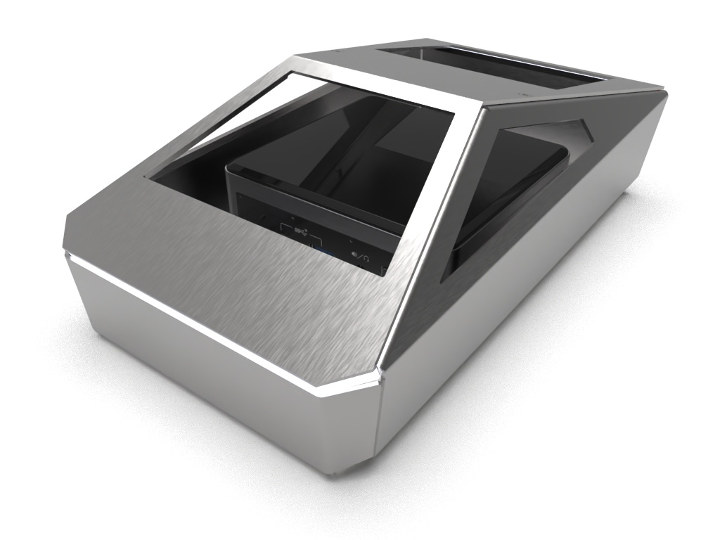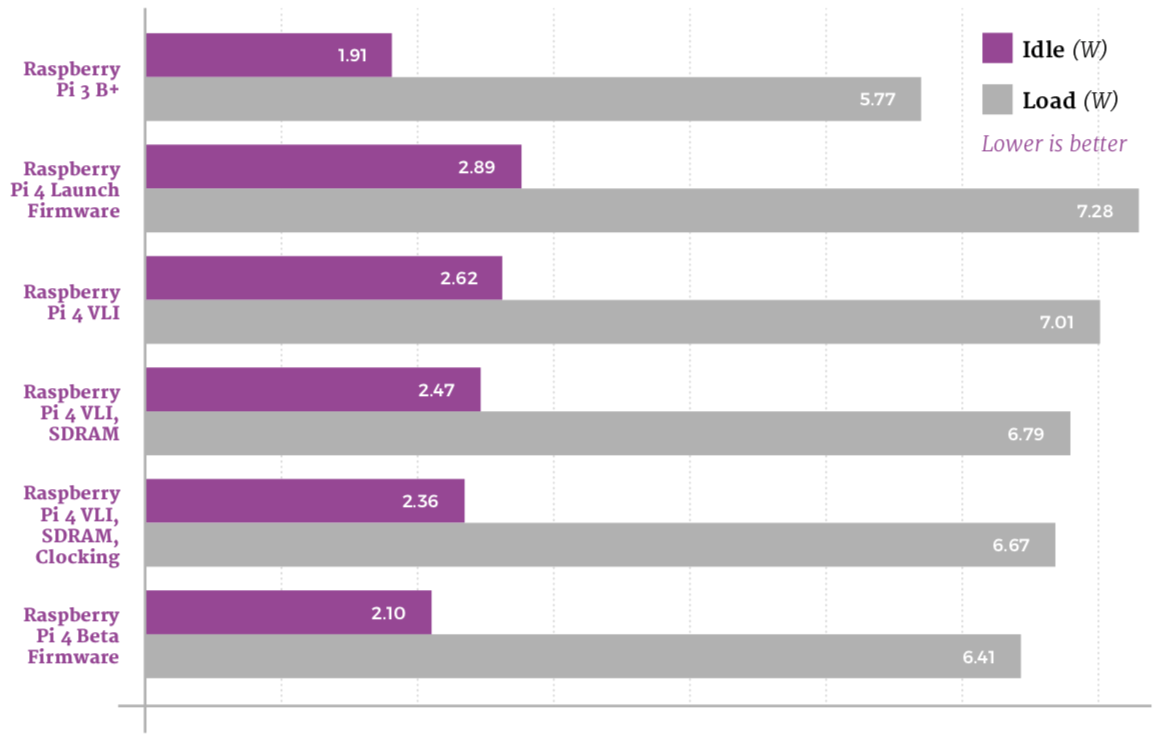We are seeing more and more RISC-V microcontrollers and processors hitting the market, but so far they all lacked a GPU for 3D graphics acceleration. Think Silicon, the make of NEMA GPU for IoT and wearables, has now announced it will demonstrate NEOX|V GPU, the first RISC-V ISA based 3D, at the RISC-V Summit at the San Jose Convention Center, on December 10-12, in San Jose, California. NEOX|V key features: Parallel multi-core and multi-threaded architecture based on the RISC-V64GC ISA instruction set with adaptive NoC (Networks-on-Chip) Configurable from 4 to 64 cores Variety of cache sizes and thread counts organized in 1 to 16 cluster elements Variety of cluster/core configurations with compute power ranging from 12.8 to 409.6 GFLOPS at 800 MHz Support for FP16, FP32, and FP64 plus SIMD instructions Beside 3D graphics, the RISC-V GPU can also be used for machine learning, vision/video processing, and open GPGPU compute […]
AWS EC2 6th Gen Instances are 7x Faster thanks to Graviton 2 Arm Neoverse N1 Custom Processor
Last year Amazon introduced their first 64-bit Arm-based ECS2 “A1” instances which were found to deliver up to 45% cost savings over x86 Instances for the right workloads. A few months ago, AWS (Amazon Web Services) provides a new offering with bare-metal A1 instances, and with re:invent 2019 now taking place the company has unveiled AWS ECS2 6th generation Arm instances (which they did not call A2 instances yet) powered by Graviton 2 processor comprised of custom Arm Neoverse N1 cores and promising up to 7x the performance of the original A1 instances. There will be three types of Graviton2-powered EC2 instances with the d suffix indicating NVMe local storage: M6g and M6gd for General Purpose workloads (application servers, mid-size data stores, microservices, and cluster computing) with 1 to 64 vCPUs and up to 256 GB of memory. C6g and C6gd for Compute-Optimized workloads (high-performance computing, video encoding, gaming, and […]
Sony Spresense 6-core MCU Development Board Now Supports Java
Sony Spresense board was introduced in spring 2018 with a 6-core Cortex-M4 microcontroller from the company, GPS & GLONASS, as well as audio support. The breadboard-compatible board could also be inserted into an Arduino UNO R3 compatible base board, and Sony offered support for both the Arduino IDE and a C-based NuttX-based SDK. You’ll find some more details and photos in our “review”. Sony has now partnered with MicroEJ to provide developers with Java support on Spresense board through MicroEJ Virtual Execution Environment (VEE). A Java simulator (VEE Virtual Device) allows you to develop software for Spresense independently of the hardware. Beside plenty of libraries, MicroEJ VEE features MEJ32 32-bit virtual core is compatible with various architectures including ARM Cortex-M, ARM Cortex-Ax, RX, V85, MIPS32, TriCore, and Tensilica. Java enables application portability which means that any GUI/IoT/Security or application code can run on various embedded systems supported by MicroEJ VEE. […]
Western Digital Made RISC-V Linux & BusyBox Boot on Sipeed Maix Go Board
The other day we wrote about Getting Started with Embedded Linux on RISC-V in QEMU emulator and noted that Linux capable RISC-V hardware is currently fairly expensive. We also mentioned there was work on porting uCLinux to Kendryte K210 RISC-V processor on boards such as Sipeed Maix board. The processor only comes with 8MB RAM, and does not feature an MMU (Memory Management Unit) so what you’d be able to do on the board would be limited, and for instance, a desktop environment is clearly impossible on the platform. NOMMU support also requires some extra work, and in Linux 5.4 we saw only of the changes was “SiFive PLIC IRQ chip modifications, in preparation for M-mode Linux”. The slide above is extracted from the “RISC-V NOMMU and M-Mode Linux” presentation by Damien Le Moal, Western Digital at the Linux Plumbers Conference 2019 last September. It explains M-mode support is better […]
Imagination Unveils IMG A-Series GPU Designed For Everything from IoT to Mobile and Server
Imagination Technologies has just launched IMG A-Series GPU which they claim is “The GPU of Everything” and “The fastest GPU IP ever”. IMG A-Series can be customized and scaled for various applications & markets from automotive, AIoT, set-top box, mobile, and server. Compared to the company’s earlier PowerVR 9Series GPU, IMG A-Series GPU delivers 2.5 times more performance, eight times faster AI processor, and 60% less power while running complex content with the same process node, area, and under similar conditions. IMG A-Series GPU supports the latest API standards including OpenGL ES, Vulkan, OpenCL, and Imagination provides a Unified AI API for use in combination with PowerVR neural network accelerators. It also offers 5x performance density compared to the best current shipping PowerVR devices and supports PVRIC4 lossless or virtually-lossless compression guaranteeing a 50% bandwidth and footprint reduction. The new GPU also leverages HyperLane Technology with up to eight individual, […]
Intel Austin Beach is a Modular, Fanless NUC Powered by Intel NUC Compute Elements
Unveiled last May, Intel NUC Compute Element is a family of cards that should cost less than the failed Computer Cards, and easy to handle than your typical computer-on-module. The first Compute Elements showcased at Computex 2019 were powered by a 15-Watt Core U-series processor, and now various models will find their way into Intel Austin Beach fanless NUC with “Chandler Bay” NUC Compute Elements powered by Whiskey Lake processors. Intel Austin Beach specifications: Chandler Bay Compute Element (one or the other, all 15-W Whiskey Lake) BKCM8CCB4R – Intel Celeron 4305U 2-core/2-thread processor with 4GB LPDDR3, 64GB eMMC storage BKCM8PCB4R – Intel Pentium Gold 5405U 2-core/4-thread processor with 4GB LPDDR3, 64GB eMMC storage BKCM8i3CB4N – Intel Core i3-8145U 2-core/4-thread processor with 4GB LPDDR3 BKCM8i5CB8N – Intel Core i5-8265U 4-core/8-thread processor with 8GB LPDDR3 BKCM8v5CB8N – Intel Core i5-8365U 4-core/8-thread vPro processor with 8GB LPDDR3 BKCM8i7CB8N – Intel Core i7-8565U 4-core/8 […]
Somebody made a Tesla Cybertruck Case for Intel NUCs
Let’s start the week on a light note… So last week, Tesla announced the Cybertruck, the first electric SUV from the company, and to be honest, at first I had to check whether I was reading the Onion or Babylon Bee because of the unconventional design of the chassis. But it’s real. Mass production is expected for the end of 2020, beginning of 2021, but you can have a miniature version (sort of) much earlier, as MyElectronics designed the CyberNUC, a stainless steel case for all 4″x4″ NUCs that closely follows the shape of the Cybertruck. We even have some specs for the CyberNUC: Compatible with NUC 5, 6, 7, 8, 9 and 10 families Stainless steel body Two screws to fit your NUC in the case Weight – 1 Kg Dimensions – L 266 x W 149 x H 88 mm You might ask: “but why?”. And indeed it […]
Run Raspberry Pi 4 Cooler with a New Firmware & One Easy Trick
Raspberry Pi 4 launched last June with a lot of buzz as it offered much better performance, more memory, and faster I/Os compared to Raspberry Pi 3 model B+. Benchmarks confirmed the improved performance but also revealed a heatsink was necessary to ensure optimal performance under heavy loads. Some companies also launched an oversized heatsink+fan combo for the board, but it’s really over the top and absolutely not necessary unless possibly in higher room temperature (50°C?). The Raspberry Pi Foundation also worked on improving the video to lower CPU temperature and power consumption, and a few days later released a beta version of VLI firmware that dropped the temperature by 3 to 5°C. Good effort but sadly the updated VLI firmware (used for the PCIe to USB controller) also had the side-effect of much slower USB performance. A new VLI firmware was released in September offering both a lower temperature […]


